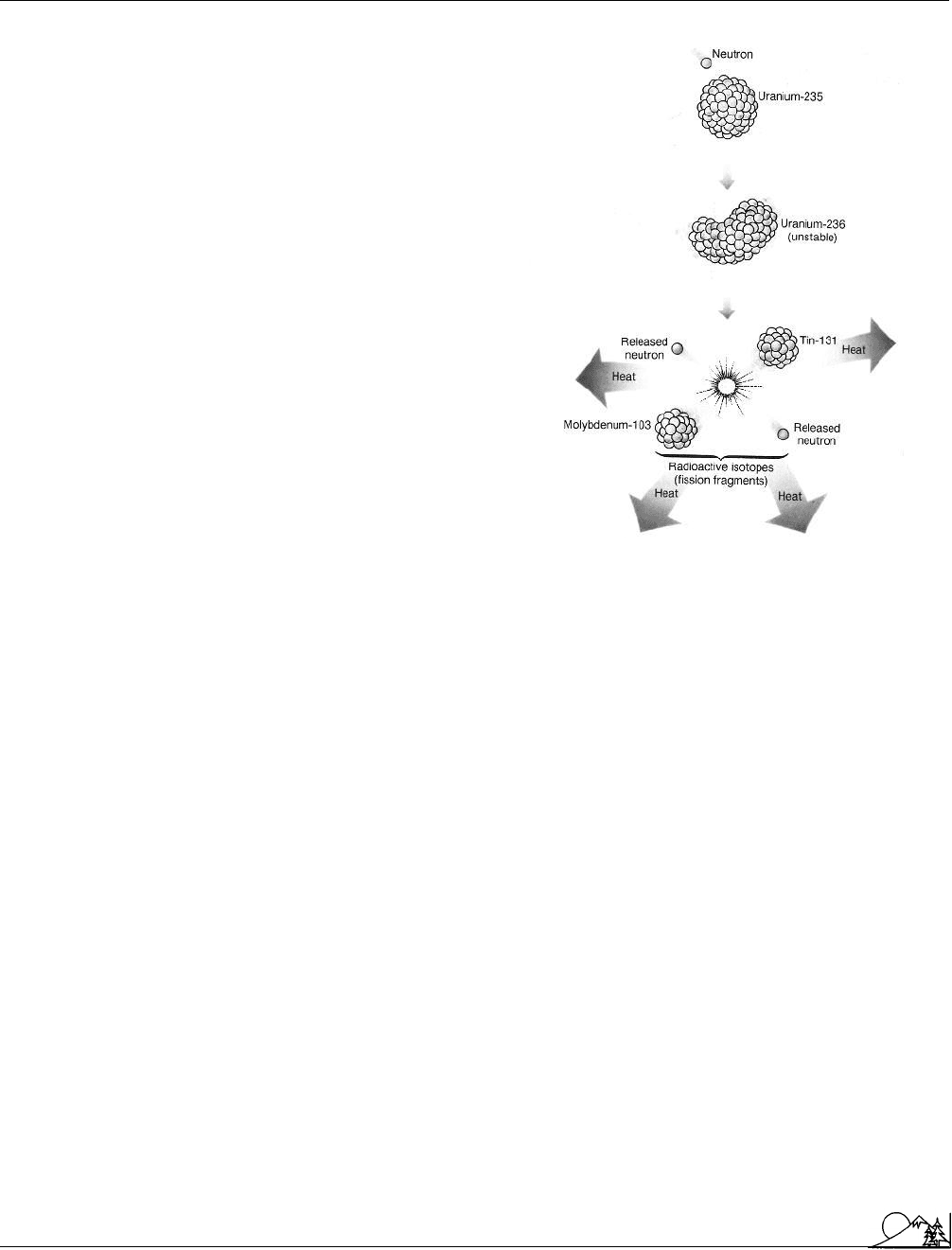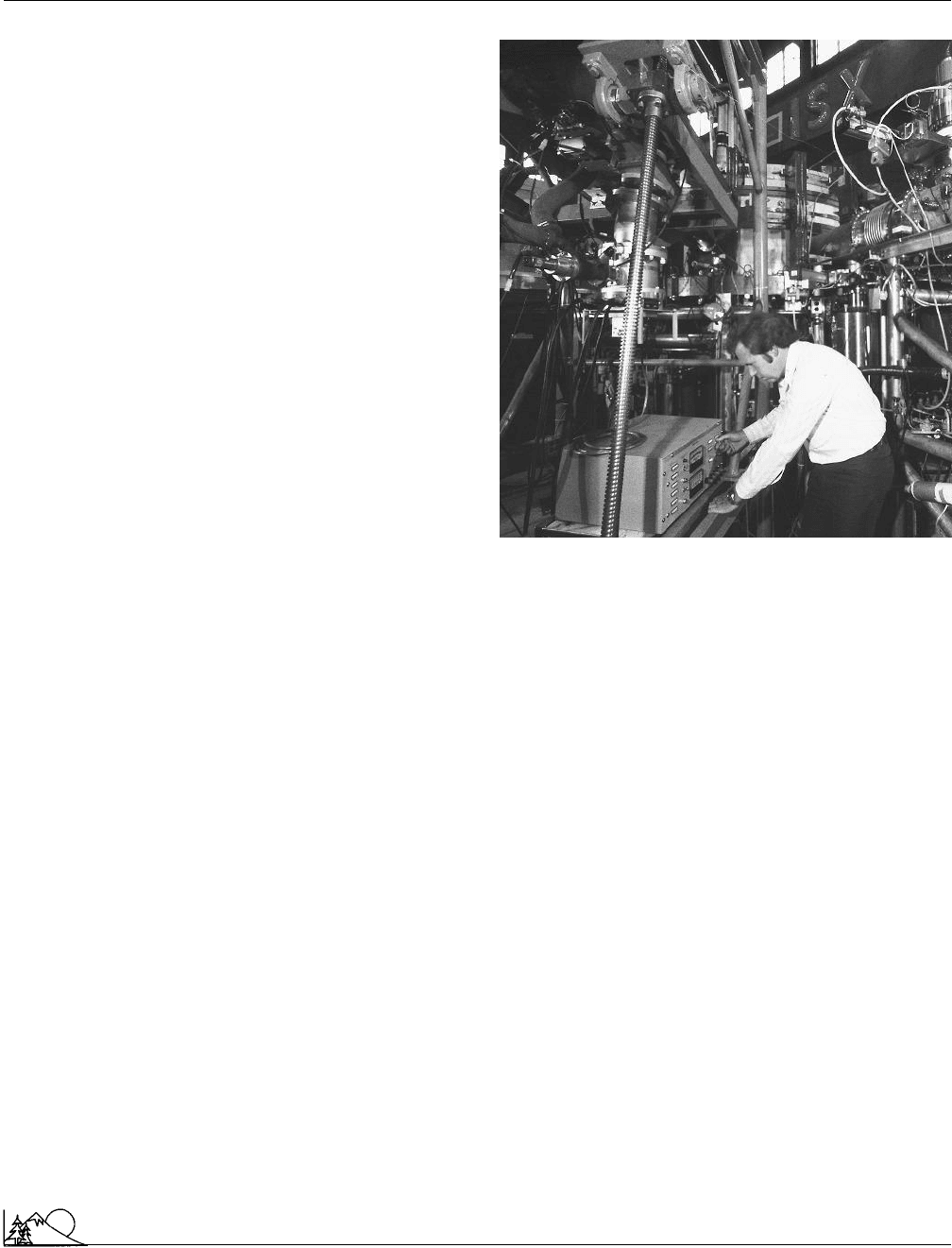Environmental Encyclopedia
Подождите немного. Документ загружается.


Environmental Encyclopedia 3
North American Free Trade Agreement
NAAEE conducts an annual conference and produces
publications, including a member newsletter, the Environ-
mental Communicator, and a Directory of Environmental Edu-
cators. It also operates a Skills Bank and numerous programs.
Several of these programs focus on community-based activi-
ties. The VINE (Volunteer-led Investigations of Neighbor-
hood Ecology) Network promotes programs using volun-
teers to lead children in explorations of the ecology of their
urban neighborhoods. The Urban Leadership Collaboratives
Program aims to develop collaborative environmental educa-
tion programs in cities. The Environmental Issues Forums
(EIF) Program assists students and adults in working with
controversial environmental issues in their communities and
nationally.
Other NAAEE programs have a wider focus. The
NAAEE Training and Professional Development Institute
offers workshops and training events on such topics as fun-
draising and long-range planning, as well as courses for
educators from developing countries in cooperation with
United States Assistance for International Development
(USAID) and the Smithsonian Institute. The Environmen-
tal Education and Training Partnership (EETAP), under a
U.S.
Environmental Protection Agency
grant, coordinates
a consortium of 18 environmental education organizations
that promote training. The NAAEE Policy Institute aims to
develop standards for environmental education. Additional
NAAEE activities include writing reports to the United
States Congress on environmental education issues, re-
viewing proposals submitted for funding under the National
Environmental Education Act of 1990, and testifying to
support environmental education legislation and innovative
programs. Internationally, the organization has helped to
establish environmental education centers in Moscow and
Kiev and a program in Thailand, and has assisted with
developing educational materials in Sri Lanka.
NAAEE maintains four member sections that repre-
sent different contexts of environmental education and con-
duct individual activities:
Conservation
Education Section,
Elementary and Secondary Education Section, Environ-
mental Studies Section, and Nonformal Section (for mem-
bers working outside of formal school settings).
In 1996, the Conservation Education Association was
incorporated into NAAEE.
[Carol Steinfeld]
R
ESOURCES
O
RGANIZATIONS
North American Association for Environmental Education, 410 Tarvin
Road, Rock Spring, GA USA 30739 (706) 764-2926, Fax: (706) 764-
2094, Email: email@naaee.org, <http://www.naaee.org>
987
North American Free Trade
Agreement
The North American Free Trade Agreement (NAFTA) is
an international trade agreement among the United States,
Canada, and Mexico that became effective on January 1,
1994. Pursuant to NAFTA most tariffs among the three
countries are being phased out over a period of fifteen years.
In addition, the agreement liberalizes rules regulating invest-
ment by United States and Canadian firms in Mexico.
NAFTA includes side agreements on
environment
, labor,
and dealing with import surges. Controversy surrounding
the adoption of NAFTA by the United States in 1993 in-
cluded issues related to trade, employment, immigration,
labor law, and environmental protection. And, several years
after its effective date, observers continue to debate the wis-
dom of the agreement. The economic slowdown in the
United States that began in 2001 has intensified public de-
bate over NAFTA’s provisions.
While NAFTA’s adoption was being debated, envi-
ronmentalists were divided in response to whether or not
we are environmentally better off with NAFTA. Thus, its
adoption was opposed by some environmental groups and
supported by others. Major groups opposing it included the
Sierra Club
,
Greenpeace
, the United States Public Interest
Research Group (U.S. PIRG), Citizen’s Action, Public Citi-
zen: the Clean Water Fund, and the
Student Environmen-
tal Action Coalition
. NAFTA was supported, however, by
a coalition of major environmental organizations including
the
National Wildlife Federation
, the
World Wildlife
Fund
, the
National Audubon Society
, the
Environmental
Defense
Council, the
Natural Resources Defense Council
,
Conservation International
, and
Defenders of Wildlife
,
and
the Nature Conservancy
. Such division among envi-
ronmentalists with respect to NAFTA and its consequences
for the environment continues through the present day.
NAFTA’s provisions
NAFTA is first and overall a trade agreement. Thus,
the majority of the provisions within its over 1,200 pages
focus on elimination of barriers to trade. Over a period of
fifteen years, beginning on January 1, 1994, tariffs on over
9,000 products traded among the United States, Mexico,
and Canada are being phased out. In addition, other “non-
tariff” barriers to trade are being eased or eliminated.
Elimination of tariffs
Tariffs on approximately 4,500 products traded among
the NAFTA parties were eliminated on January 1, 1994,
and by 1999 tariffs will remain on only about 3,000 products.
The remainder will be phased out by the year 2009. The
period during which tariffs are phased out gives producers

Environmental Encyclopedia 3
North American Free Trade Agreement
time to adjust gradually to competition from products of
other NAFTA countries. Those products for which tariffs
are being phased out gradually are labeled “sensitive prod-
ucts” and include many farm commodities. For example, to
protect Mexican producers, corn and dry beans are being
protected through a “phase-out” period for tariffs. Producers
in the United States are being protected with respect to
sugar, asparagus, orange juice concentrate, and melons.
The
automobile
industry is another area for which
NAFTA includes special provisions. NAFTA sets out for-
mulas requiring a certain minimum percentage of content
from North America (the three NAFTA parties) for an
automobile to qualify for duty-free treatment. By 2002, auto-
mobiles must contain 62.5% North American content to
qualify for such treatment.
The fact that Mexico agreed to abolish tariffs in certain
sectors of the economy is important to U.S. investors. For
example, telecommunications in Mexico are underdevel-
oped, and that country has a poor quality telephone system.
By 1998, Mexico phased out all tariffs on telecommunica-
tions service and equipment.
Removal of non-tariff barriers to trade
NAFTA removes certain barriers to trade that are not
in the form of tariffs. For example, NAFTA allows financial
service providers of a NAFTA country to establish banking,
insurance, securities operations, and other types of financial
services in another NAFTA country. NAFTA also provides
U.S. and Canadian firms with greater access to Mexico’s
energy markets. Under NAFTA, U.S. and Canadian firms
can sell products to PEMEX, Mexico’s federally owned
petroleum
company. In addition, Mexico has opened opera-
tion of self-generation,
cogeneration
, and independent
power plants
in Mexico to investment by U.S. or Cana-
dian firms.
Transportation
has also been facilitated by NAFTA.
Since 1995, U.S., Mexican, and Canadian firms have been
allowed to establish cross-border routes. In the early summer
of 2002, the United States signed an agreement allowing
Mexican trucks to travel throughout the United States. The
long-term effects of transportation agreements are difficult
to evaluate, however.
Statistics
for 2001 indicate that truck
crossings into the United States from Canada and Mexico
fell by 4.2% from their level in 2000. This decrease represents
the first annual decline since the agreement among the three
countries took effect in 1994. On the other hand, this de-
crease may be only temporary, as it reflects the impact of
tightened border security measures following the terrorist
attacks of September 11, 2001.
NAFTA does not create a common market for move-
ment of labor, but it does provide for temporary entry of
business people from one NAFTA country into another.
The four different categories for such movement of workers
988
include business visitors in marketing, sales and related activ-
ities, traders and investors, specified kinds of intracompany
transfers, and specified professionals meeting educational or
special knowledge requirements.
Dispute resolution
Administration of NAFTA is handled by a Commis-
sion of cabinet-level officers each of whom has been ap-
pointed by one of the NAFTA countries. The Commission
includes a Secretary, who is the chief administrator.
The process for resolution of disputes under NAFTA
is cumbersome and time-consuming. When a dispute arises
with respect to a NAFTA country’s rights under the
agreement, a consultation can be requested. If the consulta-
tion does not resolve the dispute, the Commission will seek
to resolve the dispute through alternative dispute resolution
procedures. If those are unsuccessful, the complaining coun-
try can request the establishment of a five member arbitration
panel which will recommend solutions, monitor results, and,
if necessary, impose sanctions.
NAFTA’s side agreements
In areas involving labor law and environmental protec-
tion, NAFTA’s provisions are limited.
Labor side agreement
The North American Agreement on Labor Coopera-
tion, also known as the “Side Agreement on Labor” or
“Labor Side Agreement,” was negotiated in response to con-
cerns that NAFTA itself did little to protect workers in
Mexico, the United States, and Canada. In the Labor Side
Agreement, the three countries articulate their desire to
improve labor conditions and encourage compliance with
labor laws. Each party agrees to enforce its own labor laws,
but new laws protecting workers are not established. The
Agreement establishes a multiple-step process for dealing
with instances in which a NAFTA country has exhibited a
“consistent pattern of ... failure to effectively enforce its own
occupational safety and health, child labor, or minimum
wage labor standards.” If the three NAFTA parties cannot
agree to a resolution, then a committee of experts can be
convened to assist in resolving the dispute.
Seven years after NAFTA was enacted, a number of
observers consider its side agreement on labor a conspicuous
failure that protected international investors at the expense
of ordinary workers in all three countries. In the United
States, NAFTA led to the elimination of 800,000 manufac-
turing jobs. Contrary to predictions in 1995, the agreement
did not result in an increased trade surplus with Mexico,
but the reverse. As manufacturing jobs disappeared, workers
in the United States were downscaled to lower-paying, less-
secure services jobs. Employers’ threats to move production
to Mexico became a powerful weapon for undercutting work-
ers’ bargaining power. In Canada, a similar process has

Environmental Encyclopedia 3
North American Free Trade Agreement
brought about a decline in stable full-time employment as
well as damaging Canada’s social safety net.
Mexican workers have not benefited from this redistri-
bution of jobs. While some manufacturing jobs did move
to Mexico, they are largely confined to maquiladoras just
across the border. Maquiladoras are factories that assemble
electronics equipment and small appliances for export.
Workers are typically paid low wages and have few rights.
The maquiladoras are isolated from the rest of the Mexican
economy and contribute very little to its development. In
addition, the expiration of the duty-free status of maquiladora
products in 2001 means that these factories are less competi-
tive in the global market. As a result, many foreign compa-
nies began to shut down their plants in Mexico in 2002.
Environmental side agreement
The North American Agreement on Environmental
Cooperation, also known as the “Environmental Side
Agreement,” was adopted along with the Labor Side
Agreement and was negotiated in response to concerns that
the body of NAFTA did little to protect the environment.
In the Environmental Side Agreement, the three parties
articulate their desire to promote environmental concerns
without harming the economy, and promote open public
discussion of environmental issues. As in the Labor Side
Agreement with respect to labor laws, each party agrees to
enforce its own environmental laws, but no new environmen-
tal laws are made. The agreement establishes a
Commission
for Environmental Cooperation
(CEC) that includes a
Secretariat and a Council, which is charged with implement-
ing the side agreement.
The Environmental Side Agreement allows a
nongov-
ernmental organization
(such as an environmental group)
or a private citizen to file a complaint with the Commission
asserting that a NAFTA country “has shown a persistent
pattern of failure to effectively enforce its environmental
laws.” Thus, such groups and individuals can serve as watch-
dogs for the Commission.
The Environmental Side Agreement allows a NAFTA
country to request a consultation with a second NAFTA
country regarding that second country’s persistent pattern
of failure to enforce its environmental laws. If a resolution
is not reached as a result of the consultation, a party can
request that the Council meet. If the Council is unable to
resolve the dispute, it can convene an arbitration panel, which
will study the dispute and issue a report. After the parties
submit comments, the report is made final. The parties are
given an opportunity to reach their own action plan, but, if
there is no such agreement, the panel can be reconvened to
establish a plan. If an imposed fine is not paid, as under the
Labor Side Agreement, NAFTA benefits can be suspended.
989
Environmental consequences of NAFTA
Environmentalists share many concerns with respect
to NAFTA, three of which will be introduced here. First,
environmentalists are concerned that NAFTA represents a
threat to the sovereignty of the United States because U.S.
environmental laws may be challenged under NAFTA. For
example, it is feared that the U.S. will not be allowed to
refuse entry of goods produced in Mexico even if those goods
are produced using production methods that do not meet
U.S. environmental, health, or food safety standards. This
is based on U.S. experience under the General Agreement
on Tariffs and Trade (GATT) when a GATT panel declared
that a U.S. embargo on Mexican tuna caught using methods
violating the U.S. Marine Mammal Protection Act was ille-
gal. The GATT panel held that products must be treated
equally regardless of how they are produced.
Ironically, the first major challenge to national sover-
eignty came from Canadian corporations. A Canadian con-
glomerate known as Methanex made use of a little-known
section of NAFTA known as Chapter 11 to sue the state
of California, demanding financial compensation for loss of
market share. Methanex is the world’s largest producer of
the key ingredient in a
gasoline
additive known as MBTE,
a substance that California ordered to be phased out after
it began to contaminate public water systems in 1995. A
phrase in Chapter 11 written to protect investors from having
their property seized by foreign governments has been in-
voked to justify corporate lawsuits against state and federal
environmental regulations. Other examples of cross-border
lawsuits include another Canadian company’s suit against
the state of Mississippi, and a United States corporation’s
suit against the government of Canada for banning another
gasoline additive.
Second, environmentalists label Mexico as a “pollution
haven” for U.S. businesses seeking less-stringent enforce-
ment of environmental laws than that which occurs in the
United States. Concerns about
environmental degrada-
tion
in Mexico due to increased industrialization do seem
to be valid. Environmentalists, business leaders, and govern-
ment officials from the three NAFTA countries agree that
environmental contamination had reached serious propor-
tions in northern Mexico in the decades preceding the 1994
effective date of NAFTA. Such contamination continues to
spread as Mexico becomes more heavily industrialized under
NAFTA. A report published by the CEC in 2002 indicates
that chemical producers accounted for the largest amount
of pollutants.
On paper, Mexico has environmental laws that parallel
many, but not all, of the federal environmental laws of the
United States. Mexico’s 1988 Co
´
digo Ecolo
´
gico, known in
English as the “General Ecology Law,” is a comprehensive
statute addressing
pollution
, resource
conservation
, and

Environmental Encyclopedia 3
North American Water and Power Alliance
environmental enforcement
. Often, however, Mexico’s
environmental laws are not enforced. This lack of enforce-
ment can be attributed to a variety of reasons. For one thing,
the statutes are relatively new, dating only from 1988, and
regulations have not been made to supplement the laws.
Also, Mexico is a country in which people distrust the legal
system and where there are widespread violations of law in
various areas (not limited to environmental laws.) Noncom-
pliance with law is accepted and expected in many areas in
Mexico. Since Mexico is a developing country striving to
implement open, democratic systems of government, this
casual attitude toward legislation is a significant hurdle to
be overcome throughout Mexican society.
Third, Mexico is a debt-ridden country that continues
to struggle with periodic financial crises. Thus, even if Mexi-
co’s leaders were convinced that there should be vigorous
enforcement of environmental laws and regulations, Mexico
lacks money for such enforcement. In connection with its
lack of capital, Mexico lacks technology and it lacks infra-
structure such as
water treatment
plants, sewage systems,
and waste disposal facilities. For example, as of mid-1997,
in the entire country of Mexico, there was only one facility
licensed for disposal of hazardous wastes. Lacking a place
to dispose of toxics and knowing the low
probability
of
being cited by government officials for violations, most com-
panies and individuals continue to dump hazardous wastes
into Mexico’s waters and air and onto its land. Mexico’s
citizens do not want to live with the contamination any
more than we do in the United States. They feel, however,
that they are less empowered to “do something about it”
than we are as U.S. citizens.
Looking ahead
NAFTA represents a significant turning point in in-
ternational law, because it recognizes explicitly that trade
policy and
environmental policy
are inextricably linked.
Through its Environmental Side Agreement, it establishes
mechanisms for dealing with citizens’ concerns and for deal-
ing with that party or country that systematically fails to
enforce its own environmental laws. However, NAFTA’s
environmental provisions provide only a foundation upon
which citizens and governments of the U.S., Mexico, and
Canada must build if the environment of North America is to
be protected from the often detrimental effects of expanded
trade. As of 2002, those detrimental effects have been suffi-
ciently obvious to produce a growing chorus of criticisms of
NAFTA. Proposals to create a Free Trade Area of the
Americas (FTAA), which would represent an extension of
NAFTA’s provisions to every country in Central America,
South America, and the Caribbean except Cuba, have pro-
voked widespread protest from a variety of environmental
and social justice organizations.
[Rebecca J. Frey, Ph.D.]
990
R
ESOURCES
B
OOKS
Bello, J. H., A. F. Holmer, and J. J. Norton, eds. NAFTA: a New Frontier
in International Trade and Investment in the Americas. American Bar Associa-
tion Section of International Law & Practice, 1994.
Hufbauer, G. C., and J. J. Schott, NAFTA: An Assessment. The Institute
for International Economics, 1993.
MacArthur, John R. The Selling of Free Trade: NAFTA, Washington, and
the Subversion of American Democracy. New York: Farrar, Straus and Gir-
oux, 2000.
Moran, R. T., and J. Abbott, NAFTA: Managing the Cultural Differences.
Gulf Publishing Company, 1994.
P
ERIODICALS
Franz, Neil. “Report Tracks NAFTA Region Emissions.” Chemical Week
164 (June 5, 2002): 39.
Knight, Danielle. “Environment Groups Organise Against NAFTA Rules.”
International Third World Press Service (IPS), September 8, 2000.
Smith, Geri. “The Decline of the Maquiladora.” Business Week. April
29, 2002.
Stenzel, P.L. “Can NAFTA’s Environmental Provisions Promote Sustain-
able Development?” 59 Albany Law Review 59 (1995): 423–480.
O
THER
Economic Policy Institute. NAFTA at Seven. Washington, DC: Economic
Policy Institute, 2001.
Global Exchange. Documentary Exposing How NAFTA’s Chapter 11 Has
Become Private Justice for Foreign Companies. January 7, 2002.
Williams, Edward J. The Maquiladora Industry and Environmental Degrada-
tion in the United States–Mexican Borderlands. Paper presented at the annual
meeting of the Latin American Studies Association, Washington, DC,
September 1995.
O
RGANIZATIONS
NAFTA Information Center, Texas A&M International University,
College of Business Administration, 5201 University Blvd., Laredo, TX
USA 78041-1900 (956)326-2550, Fax: (956)326-2544, Email:
nafta@tamiu.edu, <www.tamiu.edu/coba/usmtr/>
North American Water and Power
Alliance
Numerous schemes were suggested in the 1960s to accom-
plish large-scale water transfers between major basins in
North America, and one of the best known is the North
American Water and Power Alliance (NAWAPA). The
plan was devised by the Ralph M. Parson Company of Los
Angeles “to divert 36 trillion gallons of water (per year) from
the Yukon River in Alaska (through the Great Bear and
Great Slave Lakes) southward to 33 states, seven Canadian
provinces, and northern Mexico.”
The proposed NAWAPA system would bring water
in immense quantities from western Canada and Alaska
through the plains and
desert
states all the way down to
the Rio Grande
watershed
and into the Northern Sonora

Environmental Encyclopedia 3
Northern spotted owl
and Chihuahua provinces of Mexico. The Rocky Mountain
Trench, Peace River, Great Slave Lake, Lesser Slave Lake,
North Saskatchewan River, Columbia River, Lake Winni-
peg,
Hudson River
, James Bay, and numerous tributaries
are part of the proposed NAWAPA feeder system designed
to channel water from Canada to Mexico.
A second feeder system in the plan would channel
large quantities of water into the western portion of Lake
Superior. This influx of water would wash the pollutants
dumped into the
Great Lakes
out into the Atlantic Ocean.
It would also boost the capacity of the area for generating
hydroelectricity.
The NAWAPA plan was also designed to develop
hydroelectric plants within northern Quebec and Ontario
which would produce power that would be diverted to the
United States. The
James Bay hydropower project
in
Quebec was completed in the early 1970s. It flooded an area
4,250 mi
2
(11,000 km
2
), and 90% of its power goes directly
into the Northeastern United States and Ohio. The James
Bay II Project in Ontario will eventually incorporate over
80
dams
, divert three major rivers, and flood traditional
Cree land. The majority of its hydroelectric output will also
go to the United States.
Proponents of inter-basin transfers tend to focus on the
impending water shortages in the western and southwestern
United States. In the Great Plains, the
Ogallala Aquifer
is rapidly being depleted. The Black Mesa
water table
is
almost exhausted, due to the excessive quantities of water
used in mining operations, and California has been consist-
ently unable to meet the needs of both its industries and its
population. Supporters of NAWAPA have long argued that
this plan is the only way the nation can solve these problems.
On February 22, 1965, Newsweek hailed the NAWAPA
plan as “the greatest, the most colossal, stupendous, super-
splendificent public works project in history.”
NAWAPA was described as “a monstrous concept—
a diabolical thesis” by a former chairperson of the
Interna-
tional Joint Commission
. Much of the opposition to the
plan in the 1960s was nationalist rather than environmental
in character: The plans were viewed as an attempt to appro-
priate Canadian resources. Today, many people are asking
whether it is necessary or even right to hydrologically re-
engineer the ecosystems of North America in order to meet
the water needs of the United States. Environmentalists
point out that entire ecosystems in many western states have
already been disrupted by various water projects. They argue
that it is time to investigate other methods, such as
conser-
vation
, which would bring water consumption to levels
sustainable by the watersheds of the plains and deserts.
[Debra Glidden]
991
R
ESOURCES
B
OOKS
Higgins, J. “Hydro-Quebec and Native People.” Cultural Survival Quarterly
11 (1987).
Reisner, M. Cadillac Desert: The American West and Its Disappearing Water.
New York: Viking Press, 1986.
Royal Society of Canada. Water Resources of Canada. Ottawa: Royal Society
of Canada, 1968.
Welsh, F. How to Create a Water Crisis. Boulder: Johnson Publishing, 1985.
P
ERIODICALS
Canadian Council of Resource Ministers. Water Diversion Proposals of North
America. Ottawa: Canadian Council of Resource Ministers, 1968.
Northern spotted owl
The northern spotted owl (Strix occidentalis caurina)isone
of three subspecies of the spotted owl (Strix occidentalis).
Adults are brown, irregularly spotted with white or light
brown spots. The face is round with dark brown eyes and
a dull yellow colored bill. They are 16–19 in (41–48 cm)
long and have wing spans of about 42 in (107 cm). The
average weight of a male is 1.2 lb (544 g), whereas the
average female weighs 1.4 lb (635 g).
This subspecies of the spotted owl is found only in
the southwestern portion of British Columbia, western
Washington, western Oregon, and the western coastal region
of California south to the San Francisco Bay. Occasionally
the bird can be found on the eastern slopes of the Cascade
Mountains in Washington and Oregon. It is estimated that
there are about 3,000–5,000 individuals of this subspecies.
The other two subspecies of spotted owl are the Cali-
fornia spotted owl (S. o. occidentalis) found in the coastal
ranges and western slopes of the Sierra Nevada mountains
from Tehama to San Diego counties, and the Mexican spot-
ted owl (S. o. lucida) found from northern Arizona, south-
eastern Utah, southwestern Colorado, south through west-
ern Texas to central Mexico.
It is thought that spotted owls mate for life and are
monogamous. Breeding does not occur until the birds are
two to three years of age. The typical clutch size is two, but
sometimes as many as four eggs are laid in March or early
April. The incubation period is 28–32 days. The female
performs the task of incubating the eggs while the male bird
brings food to the newly-hatched young. The owlets leave
the nest for the first time when they are around 32–36 days
old. Without fully mature wings, the young are not yet able
to fly well and must often climb back to the nest using their
talons and beak. Juvenile
survivorship
may be only 11%.
Spotted owls hunt by sitting quietly on elevated
perches and diving down swiftly on their prey. They forage
during the night and spend most of the day roosting. Mam-
mals make up over 90% of the spotted owl’s diet. The most

Environmental Encyclopedia 3
Northern spotted owl
important prey
species
is the northern flying squirrel (Glau-
comys sabrinus) which makes up about 50% of the owl’s diet.
Woodrats and hares also are important. In all, 30 species of
mammals, 23 species of birds, two reptile species, and even
some invertebrates have been found in the diets of spotted
owls.
Northern spotted owls live almost exclusively in very
old coniferous forests. They are found in virgin stands of
Douglas fir, western hemlock, grand fir, red fir, and areas
of
redwoods
that are at least 200 years old. They favor
areas that have an old-growth overstory with layers of sec-
ond-growth understory beneath. The overstory is the pre-
ferred nesting site and the owls tend to build their nests in
trees that have broken tops or cavities, or on stick platforms.
In one study, 64% of the nests were in cavities, and the
remainder were on stick platforms or other debris on tree
limbs. All of the nests in this study were in conifers, all but
two of which were living.
Little is known about what features of a stand are
critical for spotted owls. The large trees that have nest sites
may be important, particularly those producing a multi-
layered canopy in which the owls can find a benign
microcli-
mate
. A thick canopy may be critical in sheltering juvenile
owls from avian predators, whereas the understory may be
important in providing a cool place for the birds to roost
during the warm summer months.
Because of this subspecies’ dependence on old-growth
coniferous forests and because it feeds at the top
trophic
level
in the
old-growth forest food chain/web
, it is con-
sidered an “indicator species.” Indicator species are used by
ecologists to measure the health of the
ecosystem
.Ifthe
indicator species is endangered, then it is likely that scores
of other species in the ecosystem are just as endangered.
The owls are nonmigratory, with dispersal of young
being the only regularly observed movement out of estab-
lished home ranges. The home range size of spotted owls
varies from an average of 4,200 acres (1,700 ha) in Washing-
ton to about 2,000 acres (800 ha) in California. In 1987, a
team of scientists recommended that in order to be reason-
ably sure of the species’ survival that
habitat
for 1,500 pairs
be set aside. This would necessitate preserving 4–5 million
acres (1.5–2 million ha) of old-growth forests—most of what
remains.
Unfortunately for these owls, old-growth forests are
a scarce habitat which is commercially valuable for timber.
Because of the demand for old-growth timber these birds
have been the center of controversy between timber interests
and environmentalists. The declining numbers of owls alarm
preservationists who want old-growth forests set aside to
protect the owls, while the loggers feel it is in the public’s
best interest to continue to cut the economically valuable
old-growth timber. Timber companies claim that 12,000
992
Northern spotted owl. (Photograph by John and
Karen Hollingsworth. U.S. Fish & Wildlife Service.)
jobs will be lost along with about $300 million annually if
felling is restricted.
It has been argued that since old-growth forests are
being destroyed, these jobs and revenue will be lost eventually
anyway. It has also been argued that the U. S.
Forest Service
,
which manages most of the remaining old-growth forests,
subsidizes the timber industry by building expensive access
roads and selling the timber at artificially low prices. Envi-
ronmentalists suggest that the social costs associated with
not cutting old growth could be mitigated by redirecting
these monies to retraining programs and income supple-
ments.
In 1990, the northern spotted owl was designated by
the U. S.
Fish and Wildlife Service
as a “threatened species.”
This requires that the owl’s habitat be protected from
log-
ging
. Although the decision to list the spotted owl as “threat-
ened” did not affect existing logging contracts, timber com-
panies are trying to avoid compliance with the decision.
Specifically, they are trying to persuade the President and
Congress to revise the
Endangered Species Act
to allow
consideration of economic impacts or to make a specific
exception for some or all of the spotted owl’s habitat. Cur-
rently, under certain circumstances, economic factors can
take precedence over biological criteria in deciding whether
it is necessary to comply with habitat protection measures.

Environmental Encyclopedia 3
Not In My Backyard
In these cases a special seven-person interdisciplinary com-
mittee can assess the economic impacts of protecting the
habitat and circumvent the
Endangered Species
Act if they
believe it is warranted. President Bush’s Secretary of Interior
Manuel Lujan convened the committee to consider allowing
logging in spotted owl habitat on some
Bureau of Land
Management
lands.
A team of scientists appointed by the federal govern-
ment to study the situation recommended that the annual
harvest on old-growth forests be reduced by 47%. However,
former President George Bush rejected this recommendation
and instead proposed that harvest be reduced by 21%. This
angered both the environmentalists and the timber industry
and the two sides became deadlocked. In the meantime,
spotted owl policy is being determined by federal judges
rather than biologists. For example, it was a court order that
forced the U. S. Fish and
Wildlife
Service to identify 11.6
million acres (4.7 million ha) as
critical habitat
. In 1991,
a federal judge issued an injunction stopping all new timber
sales in areas where the spotted owls live on
national forest
land. The judge also mandated that the Forest Service pro-
duce a
conservation
plan and
Environmental Impact
Statement
by March 1992. This controversy continued into
the presidency of Bill Clinton who convened a Forest Sum-
mit in Portland, Oregon on April 2, 1993, to gather informa-
tion from loggers and environmentalists. Following the sum-
mit President Clinton asked his cabinet to devise a balanced
solution to the old-growth forest dilemma within 60 days.
Ultimately the fate of the northern spotted owl will
be decided in the court rooms and halls of government,
where environmentalists and timber interests continue to
battle. It is important to realize that the dispute is not merely
over one species of owl. The spotted owl is just one of many
species dependent on old-growth forests, and may not be
in the greatest danger of
extinction
. As an indicator of the
prosperity of old-growth ecosystems in the Pacific North-
west, though, its survival means continued health for the
entire
biological community
.
[Ted T. Cable]
R
ESOURCES
B
OOKS
Hunter Jr., M. L. Wildlife, Forests, and Forestry. Englewood Cliffs, NJ:
Prentice-Hall, 1990.
“Northern Spotted Owl.” Beacham’s Guide to the Endangered Species of North
America. Farmington Hills, MI: Gale Group, 2001.
P
ERIODICALS
Casey, C. “The Bird of Contention.” American Forests 97 (1991): 28–68.
O
THER
“Northern Spotted Owl.” The Sierra Club. [cited May 2002]. <http://
www.sierraclub.org/lewisandclark/species/owl.asp>.
993
Not In My Backyard
NIMBY is an acronym for “Not In My Backyard” and is
often heard in discussions of
waste management
. While
every community needs a site for waste disposal, frequently
no one wants it near his or her home. In the early part of
this century, in fact, up until the early 1970s, the town
dump was a smelly, rodent-infested place that caught fire
on occasion. Loose debris from these facilities would also
blow onto adjacent property. Citizens were justified in their
aversion to landfills because
hazardous waste
and
chemi-
cals
were often dumped into landfills, which contaminated
groundwater
and surface water. After the passage of the
Resource Conservation and Recovery Act
(RCRA) in
1976, many of these facilities were closed and dumps con-
verted into sanitary landfills that required daily cover, fenc-
ing, leachate collection systems, and other design elements
that made them much better neighbors. Still, many citizens
refused to have landfills close to their homes.
In addition to landfills, citizens are also concerned
about having other waste management facilities near them.
Large open air
composting
facilities are not popular because
of the odor they produce. A materials
recycling
facility
(MRF) is not always a desirable neighbor because of the
noise it generate.
Despite assurances by experts of the improvements and
safety of modern waste management facilities, communities
continue to be wary of them. In order to overcome the
NIMBY attitude, professionals in the waste management
field must collaborate with communities so that citizens gain
understanding and ownership of
solid waste
management
problems. The problem of waste is generated at the commu-
nity level so the solution must be generated at the community
level. With sensible planning and patience there may be less
NIMBY-mentality in the future.
[Cynthia Fridgen]
R
ESOURCES
B
OOKS
Brion, D. J. Essential Industry and the NIMBY Phenomenon: A Problem of
Distributive Justice. Westport, CT: Greenwood, 1991.
Piller, C. The Fail-Safe Society: Community Defiance and the End of American
Technological Optimism. New York: Basic Books, 1991.
P
ERIODICALS
Guerra, S. “NIMBY, NIMTOF, and Solid Waste Facility Siting.” Public
Management 73 (October 1991): 11–15.
Shields, P. “Overcoming the NIMBY Syndrome.” American City and County
105 (May 1990): 54.
NRC
see
Nuclear Regulatory Commission

Environmental Encyclopedia 3
Nuclear fission
Nuclear accidents
see
Chelyabinsk, Russia; Chernobyl
Nuclear Power Station; Radioactive pollution;
Three Mile Island Nuclear Reactor; Windscale
(Sellafield) plutonium reactor
Nuclear fission
When a
neutron
strikes the nucleus of certain isotopes, the
nucleus breaks apart into two roughly equal parts in a process
known as nuclear fission. The two parts into which the
nucleus splits are called fission products. In addition to fis-
sion products, one or more neutrons is also produced. The
fission process also results in the release of large amounts
of energy.
The release of neutrons during fission makes possible
a
chain reaction
. That is, the particle needed to initiate a
fission reaction—the neutron—is also produced as a result
of the reaction. Each neutron produced in a fission reaction
has the potential for initiating one other fission reaction.
Since the average number of neutrons released in any one
fission reaction is about 2.3, the rate of fission in a block of
material increases rapidly.
A chain reaction will occur in a block of fissionable
material as long as neutrons (1) do not escape from the block
and (2) are not captured by nonfissionable materials in the
block. Two steps in making fission commercially possible,
then, are (1) obtaining a block of fissionable material large
enough to sustain a chain reaction—the critical size—and
(2) increasing the ratio of fissionable to nonfissionable mate-
rial in the block—enriching the material.
Atomic bombs, developed in the 1940s, obtain all of
their energy from fission reactions while
hydrogen
bombs
use fission reactions to trigger
nuclear fusion
. A long-
term environmental problem accompanying the use of these
weapons is their release of radioactive fission products during
detonation.
The energy available from fission reactions is far
greater, pound for pound, than can be obtained from the
combustion
of
fossil fuels
. This fact has made fission reac-
tions highly desirable as a source of energy in weapons and
in power production.
Many experts in the post-World War II years argued
for a massive investment in nuclear
power plants
. Such
plants were touted as safe, reliable, nonpolluting sources of
energy. When operating properly, they release none of the
pollutants that accompany power generation in fossil fuel
plants. By the 1970s, more than a hundred
nuclear power
plants were in operation in the United States.
Then, questions began to arise about the safety of
nuclear power plants. These concerns reached a peak when
994
The process of nuclear fission as carried out in
the core of a nuclear reactor. A neutron strikes
the unstable isotope Uranium-235. This isotope
absorbs the neutron and splits or fissions into
tin-131 and molybdenum-103. Two or three
neutrons are released per fission event and
continue the chain reaction. The reaction prod-
uct has a total mass slightly less than the start-
ing material with the residual mass converted
into energy (primarily heat). (McGraw-Hill Inc. Re-
produced by permission.)
the cooling water system failed at the
Three Mile Island
Nuclear Reactor
at Harrisburg, Pennsylvania, in March
1979. That accident resulted in at least a temporary halt in
nuclear power plant construction in the United States. No
new plants have been authorized since that time. A much
more serious accident occurred at Chernobyl, Ukraine, in
1986 when one of four reactors on the site exploded, spread-
ing a cloud of radioactive material over parts of the USSR,
Poland, and northern Europe.
Perhaps the most serious environmental concern about
fission reactions relates to fission products. The longer a
fission reaction continues, the more fission products accumu-
late. These fission products are all radioactive, some with
short half lives, other with longer half lives. The former can
be stored in isolation for a few years until their
radioactivity
has reduced to a safe level. The latter, however, may remain
hazardous for hundreds or thousands of years. As of the
early 1990s, no completely satisfactory method for storing

Environmental Encyclopedia 3
Nuclear fusion
these nuclear wastes had been developed. See also Nuclear
fusion; Nuclear weapons; Radiation exposure; Radioactive
pollution; Radioactive waste; Radioactive waste manage-
ment; Radioactivity
[David E. Newton]
R
ESOURCES
B
OOKS
Fowler, J. M. Energy-Environment Source Book. Washington, DC: National
Science Teachers Association, 1975.
Inglis, D. R. Nuclear Energy: Its Physics and Social Challenge. Reading, MA;
Addison-Wesley, 1973.
Joesten, M. D., et al. World of Chemistry. Philadelphia: Saunders, 1991.
Nuclear fusion
The process by which stars produce energy has always been
of great interest to scientists. Not only would the answer to
that puzzle be of value to astronomers, but it might also
suggest a method by which energy could be generated for
human use on earth.
In 1938, German-American physicist Hans Bethe
suggested a method by which
solar energy
might be pro-
duced. According to Bethe’s hypothesis, four
hydrogen
atoms come together and fuse—join together—to produce
a helium atom. In the process, very large amounts of energy
are released.
This process is not a simple one, but one that requires
a series of changes. In the first step, two hydrogen atoms
fuse to form an atom of deuterium, or “heavy” hydrogen. In
later steps, hydrogen atoms are regenerated, providing the
materials needed to start the process over again. Like
nuclear
fission
, then, nuclear fusion is a
chain reaction
.
Since Bethe’s original research, scientists have discov-
ered other fusion reactions. One of these was used in the first
practical demonstration of fusion on earth, the “hydrogen”
bomb. It involved the fusion of two hydrogen isotopes, deu-
terium and tritium.
Nuclear fusion reactions pose a difficult problem. Fus-
ing isotopes of hydrogen requires that two particles with
like electrical charges be forced together. Overcoming the
electrical repulsion of these two particles requires the initial
input into a fusion reaction of very large amounts of energy.
In practice, this means heating the materials to be fused to
very high temperatures, a few tens of millions of degrees
Celsius. Because of these very high temperatures, fusion
reactions are also known as thermonuclear reactions.
Temperatures of a few millions of degrees Celsius are
common in the center of stars, so nuclear fusion can easily
be imagined there. On earth, the easiest way to obtain such
995
Tokamak nuclear fusion reactor in Oak Ridge,
Tennessee. (Phototake. Reproduced by permission.)
temperatures is to explode a fission (atomic) bomb. That
explosion momentarily produces temperatures of a few tens
of millions of degrees Celsius. A fusion weapon such as a
hydrogen bomb consists, therefore, of nothing other than a
fission bomb surrounded by a mass of hydrogen isotopes.
As with nuclear fission, there is a strong motivation
to find ways of controlling nuclear fusion reactions so that
they can be used for the production of power. This research,
however, has been hampered by some extremely difficult
technical challenges. Obviously, no ordinary construction
material can withstand the temperatures of the hot, gaseous-
like material, or
plasma
, involved in a fusion reaction. Ef-
forts have been aimed, therefore, at finding ways of con-
taining the reaction with a magnetic field. The tokamak
reactor, originally developed by Russian scientists, appears
to be one of the most promising methods of solving this
problem.
Research on controlled fusion has been a slow, but
continuous, progress. Some researchers are confident that a
solution is close at hand. Others doubt the possibility of
bringing nuclear fusion under human control. All agree,
however, that successful completion of this research could
provide humans with perhaps the “final solution” to their
energy needs.
[David E. Newton]

Environmental Encyclopedia 3
Nuclear power
R
ESOURCES
B
OOKS
Hippenheimer, T. A. The Man-Made Sun: The Quest for Fusion Power.
Boston: Little Brown, 1984.
Inglis, D. R. Nuclear Energy: Its Physics and Social Challenge. Reading, MA;
Addison-Wesley, 1973.
P
ERIODICALS
Lidsky, L. M. “The Trouble With Fusion.” Technology Review (1984): 52–6.
Rafelski, J., and S. E. Jones. “Cold Nuclear Fusion.” Scientific American
257 (1987): 84–9.
Nuclear power
When nuclear reactions were first discovered in the 1930s,
many scientists doubted they would ever have any practical
application. But the successful initiation of the first con-
trolled reaction at the University of Chicago in 1942 quickly
changed their views.
In the first controlled nuclear reaction, scientists dis-
covered a source of energy greater than anyone had previously
imagined possible. They discovered that the nuclei of
ura-
nium
isotopes could be split, thus releasing tremendous
energy. The reaction occurred when the nuclei of certain
isotopes of uranium were struck and split by neutrons. This
is now known as
nuclear fission
, and the fission reaction
results in the formation of three types of products: energy,
neutrons, and smaller nuclei about half the size of the original
uranium nucleus.
Neutrons are actually produced in a fission reaction,
and this fact is critical for energy production. The release
of neutrons in a fission reaction means that the particles
required to initiate fission are also a product of the reaction.
Once initiated in a block of uranium, fission occurs over
and over again, in a
chain reaction
. Calculations done dur-
ing these early discoveries showed that the amount of energy
released in each fission reaction is many times greater than
that released by the chemical reactions that occur during a
conventional chemical explosion.
The possibility to release such high energies with nu-
clear reactions was used in the development of the atomic
bomb. After the dropping of this bomb brought World War
II to an end, scientists began researching the harnessing of
nuclear energy for other applications, primarily the genera-
tion of electricity. In developing the first
nuclear weapons
,
scientists only needed to find a way to initiate nuclear fis-
sion—there was no need to control it once it had begun.
In developing the peacetime application of nuclear power
however, the primary challenge was to develop a mechanism
for keeping the reaction under control once it had begun so
that the energy released could be managed and used. This
996
is the main purpose of nuclear power plants—controlling
and converting the energy produced by nuclear reactions.
There are many types of nuclear
power plants
, but
all plants have a reactor core and every core consists of
three elements. First, the fuel rods; these are long, narrow,
cylindrical tubes that hold small pellets of some fissionable
material. At present only two such materials are in practical
use, uranium-235 and plutonium-239. The uranium used
for nuclear fission is known as enriched uranium, because
it is actually a mixture of uranium-235 with uranium-238.
Uranium-238 is not fissile and the required chain reaction
will not occur if the fraction of uranium-235 present is not
at least 3%.
The second component of a reactor core is the modera-
tor. Only slow-moving neutrons are capable of initiating
nuclear fission, but the neutrons produced as a result of
nuclear fission are fast-moving. These neutrons move too
fast to initiate other reactions, thus moderators are used to
slow them down. Two of the most common moderators are
graphite (pure
carbon
) and water.
The third component of a reactor core is the control
rods. In operating a nuclear power plant safely and efficiently,
it is of the utmost importance to have exactly the right
amount of neutrons in the reactor core. If there are too few,
the chain reaction comes to an end and energy ceases to be
produced. If there are too many, fission occurs too quickly,
too much energy is released all at once, and the rate of
reaction increases until it can no longer be controlled or
contained. Control rods decrease the number of neutrons
in the core because they are made of a material that has a
strong tendency to absorb neutrons.
Cadmium
and boron
are materials that are both commonly used. The rods are
mounted on pulleys allowing them to be raised or lowered
into the reactor core as need may be. When the rods are
fully inserted, most of the neutrons in the core are absorbed
and relatively few are available to initiate a chain reaction.
As the rods are withdrawn from the core, more and more
neutrons are available to initiate fission reactions. The reac-
tions reach a point where the number of neutrons produced
in the core is almost exactly equal to the number being used
to start fission reactions, and it is then that a controlled
chain reaction occurs.
The heat energy produced in a reactor core is used to
boil water and make steam, which is then used to operate a
turbine and generate electricity. The various types of nuclear
power plants differ primarily in the way in which heat from
the core is used to do this. The most direct approach is to
surround the core with a huge tank of water, some of which
can be boiled directly by heat from the core. One problem
with boiling-water reactors is that the steam produced can be
contaminated with radioactive materials. Special precautions
must be taken with these reactors to prevent contaminated
